|
Location: Caucasus, Russia. |
Grid Reference:
37�
45�
N, 126� 26� E. |
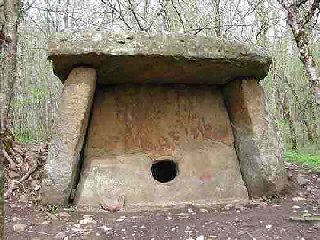
 Caucasus Dolmens:
(Russia).
Caucasus Dolmens:
(Russia).
The Caucasian dolmens represent a unique type of
prehistoric architecture, built with precisely dressed
large stone blocks. The stones were, shaped
into 90-degree angles, to be used as corners or were
curved to make a circle. The monuments date between the
end of the 4th millennium and the beginning of the 2nd
millennium B.C. They are situated in the foothills
(about 250-400 meters above the sea level) along the
coast of the Black Sea. This chain is the biggest
conglomeration of dolmens in Europe.
Approximately 3,000 of these megalithic monuments are
known in the
North-Western Caucasus, but more are constantly being
found, while more and more are also being destroyed.
Today, many are in great disrepair and will be
lost if they are not protected from vandals and general
neglect. (1)
The
Architecture of the Caucasus Dolmens.
In the
opinion of Vladimir Markovin
(3),
all forms of the Caucasus dolmens can be categorised into
four main types:
Plate
Dolmens: These dolmens are essentially stone boxes, formed
with 5 complete plates of stone. It has been established that
92% of the Caucasus dolmens were built in this fashion. They are
also considered to be some of the oldest, being dated at c.
2,700 BC.
"At the
heart of the development of West Caucasian monuments is a
plate dolmen built in the form of a simple 'house of cards'.
In all variants of dolmen construction (compound,
trough-shaped, monolith) with their complicated forms and
constructions one can see their relation with plate
monuments". "The period of flourishing of dolmen culture
fall on the 3rd and second half of the 2nd [millennium] B.C.
At that time there is a wide spread of plate constructions".
The late period of dolmen culture falls on the middle of the
2nd [millennium] B.C. Plate dolmens lose clearness of their
proportions, trough-shaped dolmens appear. By the end of the
period, dolmen-monoliths appear. Approximately by 1,400 BC,
many of the dolmens begin to be used as burials or as bone
depository. By that time they stopped building them."
(3).
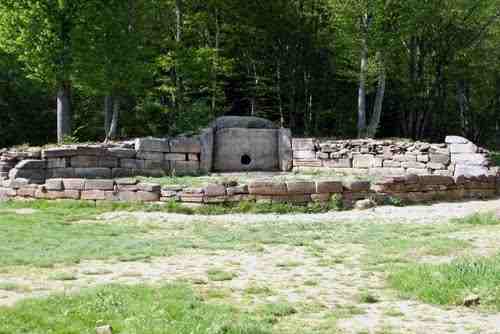
The Yara Dolmen
with facade similar in style to the Irish Court-Tombs and the
Sardinian 'Tomba di Giganti'.

A Close up of the
entrance shows the zigzag motif, common in the area and in several
Irish Passage mounds. A single zigzag line around the top of the
walls on the inside of the dolmen.
Compound
Dolmens: These dolmens were built partially into rock, but
also have walls built of smaller plates or stone blocks.
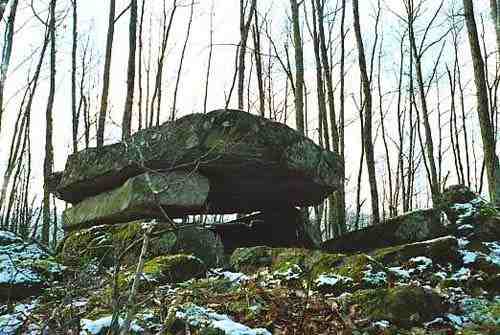
A Compound
dolmen, Caucasus, Russia.
Trough-shaped Dolmens: These structures were hollowed out
from
the living rock, then covered with removable plates.
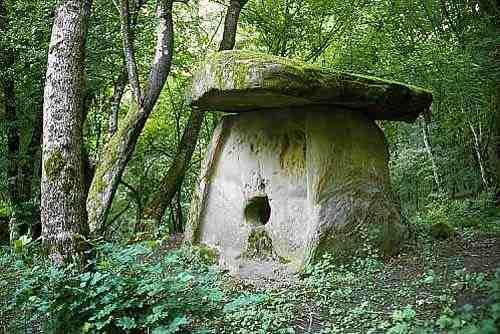
Hollowed out rock
with removable stone slab roof.
Monolithic
Dolmens: These structures were carved to simulate the
appearance of dolmens, they were entirely hollowed out in large
stones or rocks.

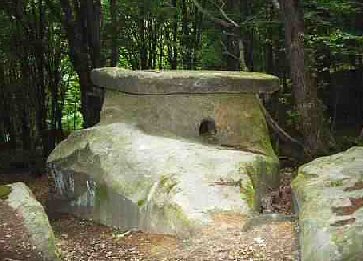
The Tuapse Dolmen
with fake portal on the rear.
The variety of decoration for these tombs is not great.
Vertical and horizontal zigzags, hanging triangles and
concentric circles are the most common motifs. One decorative
motif that is quite common is found across the top of the
porthole slab. It can best be described as a lintel held up by
two columns. Pairs of breasts, done in relief, have also been
found on a few tombs. These breasts usually appear above the two
columns of the porthole decoration. Members of Sochi
geographical Society claimed discovery of ancient writings
on Dolmens located in Sochi
area. During their expedition scientists saw images on some of
the stones and noticed that they closely resemble Asian
petroglyphs. They also believe that these petroglyphs are not
just pictures, but have a meaning.
(2)
Some unusual
items associated with dolmens are big round
stone balls, double balls and animal sculptures.
(1)
(More
about Stone Balls) |
The Portal
Holes:
All of the
dolmens are punctuated with a portal in the centre of the
facade. Some are made of more than one stone, and others carved
through a single stone. While round portholes are the most
common, square ones are also found. Related to these are the
stone plugs, which were used to block the porthole, and are
found with almost every tomb. They are sometimes phallic-shaped.
(1).
Typically, the entrance of a Caucasian dolmen is always at the
south-side (as with the Dutch Hunebeds).
.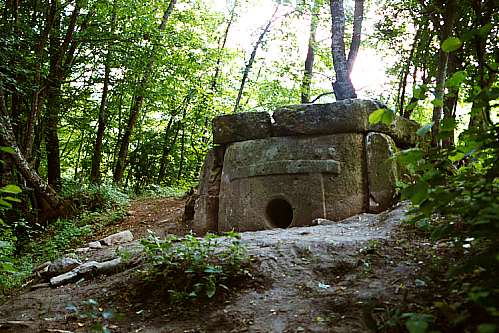
Gelendjik
dolmen: Note the carved Trilithon entrance:
(More
about Holed Stones)
Myth and Fable:
'Adygei legend says that once upon a time there were
giants in the Caucasus. they were kind and strong
creatures, and as it often happens, there were small
and spiteful people near them. they were sharp,
cunning, whining and artful people who were driven
away by their former neighbours for their meanness
and treachery. the giants gave refuge and a part of
their lands to them. They were so kind that they
made stone houses for their guests and they carried
them on their shoulders to the most beautiful and
dry places, to the banks of rivers and lakes.
Instead of doors they breached round holes through
which little people went hunting on lop-eared hares.
However the giants were repaid for their kindness.
In order to tame the giants the little people
blinded them and began to give them different herbs
and because of it, the giants began to lose their
minds and conflict with each other. Once the giants
freed themselves from charms a war began, resulting
in everyone's death with just the stone houses
remaining'.
(More
about Giants)
The Kolikho Disc:
The restoration of
the "Kolikho" Dolmen from the Tuapse region, on the Black sea coast,
Russia), was successfully completed in 2009. The dolmen was found by
accident after the seasonal flood in 2008. It was buried beneath 3
m-thick river deposits and left untouched since the Bronze Age.
"It's not
the largest dolmen, or the best-preserved, and certainly not
the most beautiful," said Dr. Viktor Trifonov, a Bronze Age
expert and the head of the restoration project. What makes this
object unique, he said, is its status as "the first honestly
acquired museum dolmen."..."These [monuments] were built to be
part of the landscape," Trifonov said, "Ancient people would see
them and understand � this is a tomb holding someone's remains,
this is someone's territory. It's an entire language."
(4)

The Kolikho Plate
Dolmen and goods on display in the Moscow State Museum.
The burial chamber
was full of partly disarticulated human remains. All of them were
put in the chamber through the hole in the fa�ade slab. Radiocarbon
dates of human remains (72 people) covers the period (approx.)
between 1800 and 1300 B.C. with no signs of chronological gaps. In
other word, the dolmen was in use for about 500 years. The grave
goods were small and consist of pottery, a bronze javelin head,
bronze spiral earrings, a bone belt buckle, a few stone flakes and a
sandstone disk about the size of a dinner plate with signs on both
sides.
On one side of the
disk are �astral� symbols (an eight pointed star), on other side -
marks along the rim of the disk. The last thing is absolutely
unexpected find! It looks like sort of device, perhaps the Caucasan
version of the Nebra disk. At present
nothing more is known.
(More
about Archaeoastronomy)
Gallery of Images: The Caucasan Dolmens:
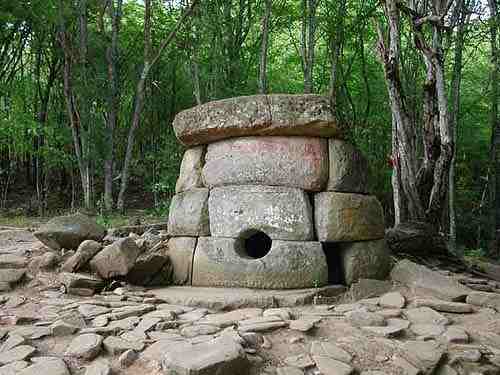
The Jane Valley Dolmen, Russia with
stone pavement.

The Mamed Canyon Dolmen, with its
appearance of a pyramid from the side.
(Dolmens Homepage)
(Arkaim,
Russia)
(Holed Stones) (Index
of Ancient sites) |










